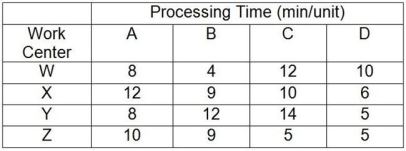Table 5.2
A company makes four products that have the following characteristics: Product A sells for $75 but needs $20 of materials and $20 of labor to produce; Product B sells for $90 but needs $45 of materials and $20 of labor to produce; Product C sells for $110 but needs $50 of materials and $30 of labor to produce; Product D sells for $135 but needs $75 of materials and $40 of labor to produce. The processing requirements for each product on each of the four machines are shown in the table.

Work centers W, X, Y, and Z are available for 40 hours per week and have no setup time when switching between products. Market demand is 50 As, 60 Bs, 70 Cs, and 80 Ds per week. In the questions that follow, the traditional method refers to maximizing the contribution margin per unit for each product, and the bottleneck method refers to maximizing the contribution margin per minute at the bottleneck for each product.
-Use the information in Table 5.2. Using the bottleneck method, which product should be scheduled first?
Definitions:
Vegetable Oils
Edible oils extracted from plants' seeds, fruits, or other parts, widely used in cooking and food preparation.
Hydrolysis
A chemical reaction involving the breakdown of a compound by water, leading to the separation of molecules.
Requires Water
Pertains to processes, organisms, or reactions that need water to function or occur.
Hydrolysis
A chemical process that splits molecules by adding water, commonly involved in breaking down polymers into monomers.
Q14: _ is the maximum rate of output
Q23: The value stream mapping tool often requires
Q42: _ are useful capacity analysis tools when
Q61: Assignable causes of variation include any variable-causing
Q75: While lean systems work very well for
Q75: Demand for a new five-inch color TV
Q86: How can Theory of Constraints principles be
Q126: Line balancing strives to create workstations so
Q138: The just-in-time (JIT)system is a(n):<br>A)management system of
Q182: A metal-cutting operation has a target value